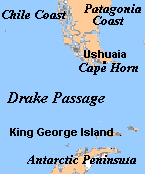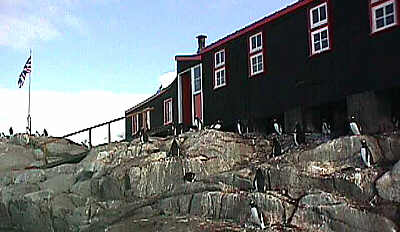 |
|
 click map for more detailed location info |

Port Lockroy
Report 13 February - Team B on board Pelagic at Port Lockroy
Sat 13th FebWe were very happy to hear that there have been 30.000 visits to the Mission Antarctica website in the last few weeks. We hope you continue taking interest in our expedition and maybe you could pass the Internet address on to friends or colleagues who might be interested in the Antarctic and following our exploits.
During our visit to the historic site of Port Lockroy we had a short but special encounter with Francois de Gerlache, who is a grandson of the famous Adriaen de Gerlache. Adriaen, who served in the royal belgian navy, led an expedition to the Antarctic in 1898 and 1899. With his vessel the Belgica, Adriaen de Gerlache got stuck in the ice in the channel now known as Gerlache Strait ( where we are now sailing) for almost a year. Grandson Francois is here on the Vavilov, a former Russian research vessel.
The Belgians have chartered the ship over three years (1997,1998 and 1999) to travel along the peninsula to commemorate Gerlaches expedition and the voyage of the Belgica. This was the last trip in the series. Francois and his father, Adriaen's son, turned out to be as adventurous as their famous ancestor. Fifteen years ago they were the first to winter in tents in the Antarctic. According to Francois it was not that bad, the lowest temperature was 'just' 20 degrees below zero. His grandfather had worse circumstances to endure. At the end of this report you will find the story of this memorable expedition. Today the first episode. Tomorrow the second and last one.
Today we are enjoying another day of splendid weather. You can easily sit between the penguins observing them for hours without getting really cold. We had an interview with Nigel, a British researcher working at Port Lockroy, who is studying the behaviour of penguins and the impact of humans on them.
Port Lockroy is one of the most visited places in the Antarctic. This year 6,500 people visited this site. Nigel has divided the island into four sectors. In two no people are allowed to enter. In the other two sectors visitors are rather encouraged to go and approach the penguins. According to Nigel the penguins show no signs of being disturbed in their daily life. The breeding patterns are still the same and there are so far no changes in the size of the population. However to be able to draw conclusions, more years of research are needed. Here on the shores of the sea you see how nature works. Life for a penguin is a matter of eat or to be eaten.
Some of the smallest penguin babies (size 15 cm) will not survive. They were born too late in the season and will not grow up quickly enough to survive the coming winter. Some other chicks will die because their mothers got caught and eaten by the seals. The unfortunate young ones will starve to death. That may be a sad ending for these sweet fluffy animals, but on the other hand, they will provide food for little skua's or sheathbills. In this way no living creature is really spoiled in nature.
Tonight we will have a meal at the base. Nigel and Dave, the other man living at the base this summer, will cook dinner. The crew of the other two yachts in this bay are invited as well. We hope to meet the two sailors of berserk, the smallest yacht we have encountered so far. It is hardly 30 feet long and we have heard it has problems with it's engine. Berserk's two crew plan to sail to Cape Town in Africa. We wish them all the luck of the world, they look like like they need it!
The Belgica Voyage 1898-1899
In July 1895, Adriaen Victor Joseph de Gerlache attended the sixth International Geographical Congress that was held in London to rekindle the interest in Antarctic exploration. Hardly any part of the antarctic was charted by that time. (Note:even nowadays there are still areas that are not yet properly surveyed. A strange situation in a world where we are used to having almost every blade of grass is charted). The Congress passed a resolution that stated that further exploration of the Antarctic should be undertaken before the close of the century. This was exactly in line with the idealistic aims of Adriaen de Gerlache, who at that time was a young lieutenant in the Belgian Royal Navy. The 29 year old man started fund-raising to finance a discovery voyage to the far south. He had great difficulty because the Belgian government was not really interested. They had just acquired a new colony -Congo- and were unwilling to finance a trip to the ice. But at last Adriaen managed to raise 300.000 francs with which he bought an old 30 metres long three masted whaler. He converted it into an expedition vessel by building new cabins for the officers and the scientists and he rechristened the vessel the 'Belgica'.
The crew were recruited from many countries, among them were the later explorer Amundsen and the American Frederic Cook. The Belgica set sail to Punta Arenas in August 1898. They arrived there in November but stayed to do scientific research in Tierra del Fuego. They did not leave for Antarctica until the 14th of December. Although critics later pointed out that this late departure was a fatal mistake their research could have been done on the way back home. As a result they were rather late in the Antarctic summer season for an exploratory trip.
The Belgica reached the peninsula and sailed along until it was hit by a strong gale at the end of January. During this gale the stores of coal got free from the containers choking the scuppers. The crew had to work work hard to solve this problem, because too much water on deck destabilizes the ship and causes a very dangerous situation. Unfortunately one young sailor Carl Wiencke fell overboard. At first they managed to keep him hanging on a rope, but in the end he lost his grip of the logline and drowned. This tragedy heralded the beginning of a horrible year for the Belgica.
The following weeks were at first successful in discovering new islands and coastlines. De Gerlache did twenty landings. Many islands got the names of Belgian towns and provinces, such as Brabant island and Anvers island. One island was named after the unfortunate sailor Wiencke island, a cold comfort. On the 15th of February they crossed the antarctic circle but after that fate turned against them... to be continued in tomorrow's report.
Kirsten Kuipers
| Weather and Position Data | |||
| 1. Date | 2. Time | 3. Posn Lat | 4. Posn Long |
| 13/02 | 10.44 local | 64°-49.68S | 63°-29.37W |
| 5. Compass Heading | 6. Wind Speed | 7. Boat speed | 8. Wind Dir |
| 49° | 12 Knots | 0 Knots | +90° |
| 9. Pressure | 10. Air Temp | 11. Sea Temp | 12. Cloud Type |
| 972 | +6°C | no data | cumulus |
| 13. Cloud cover | 14. Precipitation | 15. Sea State | 16.Comments |
| 60% | none | anchored | wind chill -2 |